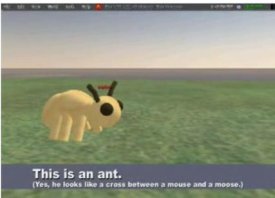Order Of The Science Scouts Of Exemplary Repute And Above Average Physique
I was pointed to this site by BoingBoing this morning and have now wasted way too much time poring over their science merit badges. I must now declare the badges for which I qualify for:
 The "I blog about science" badge. In which the recipient maintains a blog where at least a quarter of the material is about science. Suffice to say, this does not include scientology
The "I blog about science" badge. In which the recipient maintains a blog where at least a quarter of the material is about science. Suffice to say, this does not include scientology
 The "talking science" badge. Required for all members. Assumes the recipient conducts himself/herself in such a manner as to talk science whenever he/she gets the chance. Not easily fazed by looks of disinterest from friends or the act of "zoning out" by well intentioned loved ones
The "talking science" badge. Required for all members. Assumes the recipient conducts himself/herself in such a manner as to talk science whenever he/she gets the chance. Not easily fazed by looks of disinterest from friends or the act of "zoning out" by well intentioned loved ones
 The "inordinately fond of invertebrate" badge. In which the recipient professes an arguably unhealthy affinity for things of this category.
The "inordinately fond of invertebrate" badge. In which the recipient professes an arguably unhealthy affinity for things of this category.
Clearly, I deserve this badge, but why the squid? There needs to be an insect version.
 The "respect me - I've published at an upper tier publication for popular science readership" badge. In which the recipient has works in print at publications with circulations of 50,000 or higher.
The "respect me - I've published at an upper tier publication for popular science readership" badge. In which the recipient has works in print at publications with circulations of 50,000 or higher.
Well, I don't know what the circulation of Naturwissenschaften is, but I'm pretty sure I qualify.
 The "have used a dental drill and I've never been a dentist" badge. We're not sure if this is a specialist badge. We do hope so, though.
The "have used a dental drill and I've never been a dentist" badge. We're not sure if this is a specialist badge. We do hope so, though.
Okay, I haven't used a dental drill, but I have used a DeWalt 2-1/2" 24V cordless drill/hammerdrill with a 24" long auger drill bit attachment. That's gotta count for something, right?
 The "inappropriate nocturnal use of lab equipment in the name of alternative science experimentation / communication" badge. In which the recipient has "borrowed" scientific supplies for the sake of stealth scientific communication.
The "inappropriate nocturnal use of lab equipment in the name of alternative science experimentation / communication" badge. In which the recipient has "borrowed" scientific supplies for the sake of stealth scientific communication.
'nuff said.
 The "experienced with electrical shock" badge (LEVEL III). In which the recipient has had experience with the electrical shocking of himself/herself.
The "experienced with electrical shock" badge (LEVEL III). In which the recipient has had experience with the electrical shocking of himself/herself.
Not fun. I once electrocuted myself (accidentally) while working on a black-footed ferret reintroduction program in South Dakota. We set up large areas protected by electric fencing to keep out coyotes and one day I just barely brushed the fence with a finger. Next thing I knew I was lying flat out on the ground staring up at the sky.
 The "arts and crafts" badge. Because you can't have a bunch of badges without an arts and crafts badge. This one assumes the recipient has all manner of "craftiness" with a sciencegeek twist.
The "arts and crafts" badge. Because you can't have a bunch of badges without an arts and crafts badge. This one assumes the recipient has all manner of "craftiness" with a sciencegeek twist.
I offer as proof, The Gigantiops Destructor Store.
 The "has frozen stuff just to see what happens" badge (LEVEL II). In which the recipient has frozen something in dry ice for the sake of scientific curiosity.
The "has frozen stuff just to see what happens" badge (LEVEL II). In which the recipient has frozen something in dry ice for the sake of scientific curiosity.
Well, who hasn't?
 The "I may look like a scientist but I'm actually also a ninja" badge. Lethal when in combination with the "destroyer of quackery" badge.
The "I may look like a scientist but I'm actually also a ninja" badge. Lethal when in combination with the "destroyer of quackery" badge.
Here is my proof.
 The "dodger of monkey shit" badge. One of our self explanatory badges.
The "dodger of monkey shit" badge. One of our self explanatory badges.
Let's just say Tiputini has a lot of monkeys.
Link for explanations, more badges, and a place to suggest merit badges of your own!




















